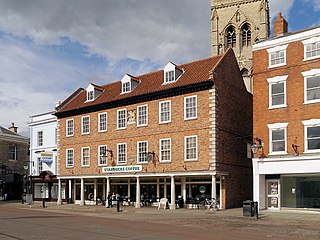
Newark-on-Trent or Newark is a market town and civil parish in the Newark and Sherwood district in Nottinghamshire, England. It is on the River Trent, and was historically a major inland port. The A1 road bypasses the town on the line of the ancient Great North Road. The town's origins are likely to be Roman, as it lies on a major Roman road, the Fosse Way. It grew up around Newark Castle, St Mary Magdalene church and later developed as a centre for the wool and cloth trades.
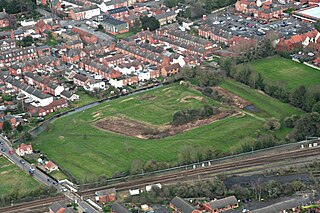
Sleaford is a market town and civil parish in the North Kesteven district of Lincolnshire, England. On the edge of the Fenlands, it is 11 miles north-east of Grantham, 16 mi (26 km) west of Boston, and 17 mi (27 km) south of Lincoln. It is the largest settlement in North Kesteven with a population of 19,807 in 2021. Centred on the former parish of New Sleaford, the modern boundaries and urban area include Quarrington to the south-west, Holdingham to the north-west and Old Sleaford to the east. The town is bypassed by the A17 and the A15 roads, which link it to Lincoln, Newark, Peterborough, Grantham, Boston and King's Lynn. Sleaford railway station is on the Nottingham to Skegness and Peterborough to Lincoln lines.
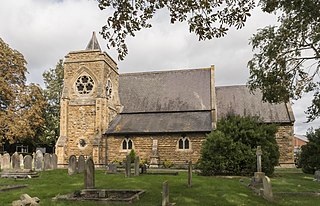
North Hykeham is an industrial town and civil parish in the North Kesteven District of Lincolnshire, England. It is located directly south of the city of Lincoln, where it forms the southern part of the wider Lincoln Urban Area along with Waddington, Bracebridge Heath, Canwick and South Hykeham. The parish covering the town had a population of 16,844 in the 2021 Census.
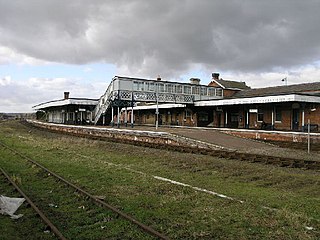
Sleaford railway station serves the town of Sleaford in Lincolnshire, England. It lies on the Peterborough–Lincoln line. The station is 21 miles (34 km) south of Lincoln Central.

Sleaford Castle is a medieval castle in Sleaford, Lincolnshire, England. Built by the Bishop of Lincoln in the early 1120s, it was habitable as late as 1555 but fell into disrepair during the latter half of the 16th century. Two English monarchs are known to have stayed at the castle, King John and Henry VIII.

The Sleaford Navigation was a 12.5-mile (20.1 km) canalisation of the River Slea in Lincolnshire, England, which opened in 1794. It ran from a junction with the River Witham, near Chapel Hill to the town of Sleaford through seven locks, most of which were adjacent to mills. Lack of finance meant that it stopped short of its intended terminus, but it gradually grew to be successful financially. The coming of the railways in 1857 led to a rapid decline, and it was officially abandoned by an act of Parliament in 1878, but remained open for a further three years. The lower part of it remained navigable until the 1940s, when it was blocked by a sluice.

John Hussey, 1st Baron Hussey of Sleaford was Chief Butler of England from 1521 until his death. He was a member of the House of Lords, and a Chamberlain to King Henry VIII's daughter, Mary I of England.
Benjamin Handley was an English soldier and Liberal politician who sat in the House of Commons from 1832 to 1835. His family were prominent in Lincolnshire during the 18th and 19th Centuries.

Quarrington is a village and former civil parish, now part of the civil parish of Sleaford, in the North Kesteven district of Lincolnshire, England. The old village and its church lie approximately 1 miles (2 km) south-west from the centre of Sleaford. Suburban housing developments at New Quarrington and Quarrington Hill effectively link the two settlements. Bypassed by the A15, it is connected to Lincoln and Peterborough, as well as Newark and King's Lynn. At the 2011 census, Quarrington and Mareham ward, which incorporates most of the settlement, had an estimated population of 7,046.

St Denys' Church is a medieval Anglican parish church in Sleaford, Lincolnshire, England. While a church and a priest have probably been present in the settlement since approximately 1086, the oldest parts of the present building are the tower and spire, which date to the late 12th and early 13th centuries; the stone broach spire is one of the earliest examples of its kind in England. The Decorated Gothic nave, aisles and north transept were built in the 14th century. The church was altered in the 19th century: the north aisle was rebuilt by the local builders Kirk and Parry in 1853 and the tower and spire were largely rebuilt in 1884 after being struck by lightning. St Denys' remains an active parish church.

Culverthorpe is a hamlet in the civil parish of Culverthorpe and Kelby, in the North Kesteven district of Lincolnshire, England. It lies 5 miles (8 km) south-west from Sleaford, 9 miles (14 km) north-east from Grantham and 3 miles (5 km) south-east from Ancaster.

Holdingham is a hamlet in the civil parish and built-up area of Sleaford, in the North Kesteven district of Lincolnshire, England. It is bisected by Lincoln Road (B1518) which joins the A17 and A15 roads immediately north of the settlement; those roads connect it to Lincoln, Newark, Peterborough and King's Lynn. Sleaford railway station is on the Nottingham to Skegness and Peterborough to Lincoln Lines.
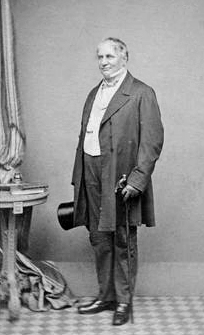
George Hussey Packe was a United Kingdom Member of Parliament, an army officer present at the Battle of Waterloo, and was instrumental in establishing the Great Northern Railway.
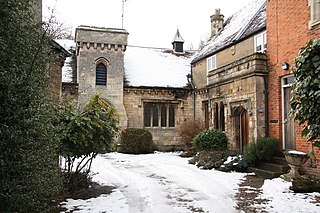
The Manor House is a set of connected buildings located on Northgate in the English town of Sleaford, Lincolnshire. A complex arrangement, parts of the Manor House date to the 16th century, but they were extended with the addition of the Georgian Rhodes House and later Gothic-Revival work. It was a private residence until the 20th century, and is now divided into commercial properties and residential apartments. The house was owned by a number of families and individuals, including local banker and businessman Benjamin Handley and Sophia Peacock, whose nephews, Cecil and Frank Rhodes, spent their summers at the estate as children.

Sleaford – historically called New Sleaford – is a market town in the North Kesteven district of Lincolnshire, England. There are 181 listed buildings in the civil parish of Sleaford, which, along with the town, incorporates the village of Quarrington, the hamlet of Holdingham and the former ancient parish of Old Sleaford. One of the buildings is classified by Historic England as being in Grade I, six in Grade II* and 174 in Grade II.
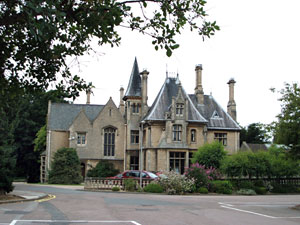
Westholme House is a historic building in the English market town of Sleaford in Lincolnshire, set in 32 acres of parkland and school grounds. Built around 1849 in the style of a French Gothic mansion by Charles Kirk for his business partner Thomas Parry, it was privately owned until the 1940s, when Kesteven County Council acquired the house and its grounds. It subsequently served as the county library and part of Sleaford Secondary Modern School. The stone house follows an asymmetrical layout and incorporates a range of Gothic elements in its design. In 1974, it was recorded in the National Heritage List for England as a designated Grade II listed building, recognising it as of "special interest".

Charles Kirk (1791–1847) was a builder and architect who worked on many buildings in Sleaford and South Lincolnshire, England.
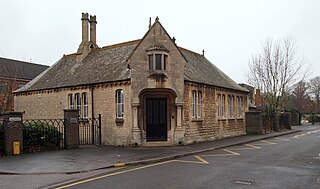
Kirk and Parry were an architectural and civil engineering practice in Sleaford that specialised in the design of public buildings, housing and the construction of Railways. The practice was initially founded by Charles Kirk (senior) (1791–1847). Thomas Parry, (1818-1879) was an articled clerk to Charles Kirk. Parry married Henrietta, daughter of Charles Kirk in 1841 and formed a partnership with Charles Kirk. Following the death of Charles Kirk in 1847, his son, Charles Kirk (junior) (1825-1902), then became a partner with Thomas Parry. Charles Kirk Junior was the architect in the practice and Parry probably acted as an administrator. Thomas Parry was a Liberal Party politician from who sat in the House of Commons for three short periods between 1865 and 1874. By 1903 the firm had changed its name to Kirk, Knight and Co. This article surveys the work of Kirk and Parry and its successor firm, from 1847 until it ceased trading in 1906.
Henry Handley was a British Whig politician.

















